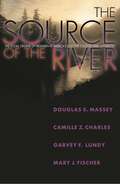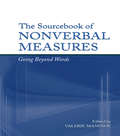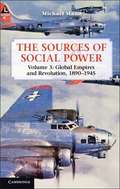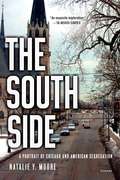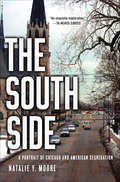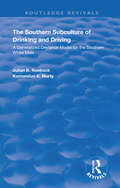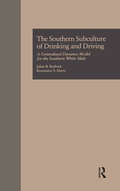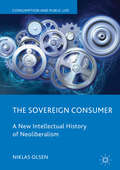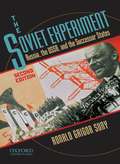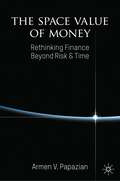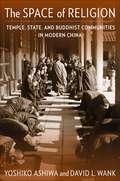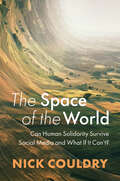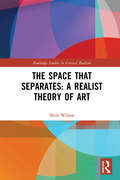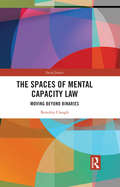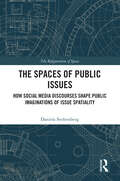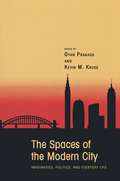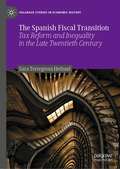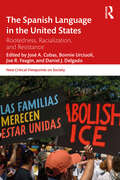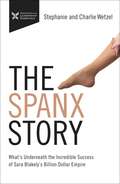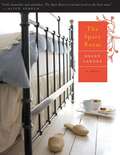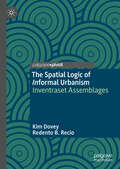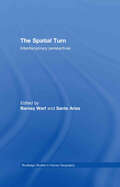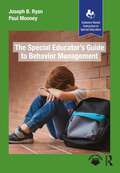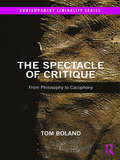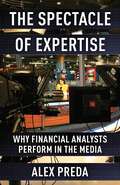- Table View
- List View
The Source of the River: The Social Origins of Freshmen at America's Selective Colleges and Universities (The William G. Bowen Series #43)
by Douglas S. Massey Garvey Lundy Mary J. Fischer Camille Z. CharlesAfrican Americans and Latinos earn lower grades and drop out of college more often than whites or Asians. Yet thirty years after deliberate minority recruitment efforts began, we still don't know why. In The Shape of the River, William Bowen and Derek Bok documented the benefits of affirmative action for minority students, their communities, and the nation at large. But they also found that too many failed to achieve academic success. In The Source of the River, Douglas Massey and his colleagues investigate the roots of minority underperformance in selective colleges and universities. They explain how such factors as neighborhood, family, peer group, and early schooling influence the academic performance of students from differing racial and ethnic origins and differing social classes. Drawing on a major new source of data--the National Longitudinal Survey of Freshmen--the authors undertake a comprehensive analysis of the diverse pathways by which whites, African Americans, Latinos, and Asians enter American higher education. Theirs is the first study to document the different characteristics that students bring to campus and to trace out the influence of these differences on later academic performance. They show that black and Latino students do not enter college disadvantaged by a lack of self-esteem. In fact, overconfidence is more common than low self-confidence among some minority students. Despite this, minority students are adversely affected by racist stereotypes of intellectual inferiority. Although academic preparation is the strongest predictor of college performance, shortfalls in academic preparation are themselves largely a matter of socioeconomic disadvantage and racial segregation. Presenting important new findings, The Source of the River documents the ongoing power of race to shape the life chances of America's young people, even among the most talented and able.
The Sourcebook of Nonverbal Measures: Going Beyond Words
by Valerie ManusovThe Sourcebook of Nonverbal Measures provides a comprehensive discussion of research choices for investigating nonverbal phenomena. The volume presents many of the primary means by which researchers assess nonverbal cues. Editor Valerie Manusov has collected both well-established and new measures used in researching nonverbal behaviors, illustrating the broad spectrum of measures appropriate for use in research, and providing a critical resource for future studies.With chapters written by the creators of the research measures, this volume represents work across disciplines, and provides first-hand experience and thoughtful guidance on the use of nonverbal measures. It also offers research strategies researchers can use to answer their research questions; discussions of larger research paradigms into which a measure may be placed; and analysis tools to help researchers think through the research choices available to them.With its thorough and pragmatic approach, this Sourcebook will be an invaluable resource for studying nonverbal behavior. Researchers in interpersonal communication, psychology, personal relationships, and related areas will find it to be an essential research tool.
The Sources of Social Power
by Michael MannDistinguishing four sources of power – ideological, economic, military and political – this series traces their interrelations throughout human history. This third volume of Michael Mann's analytical history of social power begins with nineteenth-century global empires and continues with a global history of the twentieth century up to 1945. Mann focuses on the interrelated development of capitalism, nation-states and empires. Volume 3 discusses the 'Great Divergence' between the fortunes of the West and the rest of the world; the self-destruction of European and Japanese power in two world wars; the Great Depression; the rise of American and Soviet power; the rivalry between capitalism, socialism and fascism; and the triumph of a reformed and democratic capitalism.
The South Side: A Portrait of Chicago and American Segregation
by Natalie Y. MooreChicago-native Natalie Moore shines a light on contemporary segregation in the city's South Side; with a memoirist's eye, she showcases the lives of these communities through the stories of people who reside there. The South Side shows the impact of Chicago's historic segregation - and the ongoing policies that keep the system intact.
The South Side: A Portrait of Chicago and American Segregation
by Natalie Y. Moore**One of Buzzfeed's 18 Best Nonfiction Books Of 2016**A lyrical, intelligent, authentic, and necessary look at the intersection of race and class in Chicago, a Great American CityIn this intelligent and highly important narrative, Chicago-native Natalie Moore shines a light on contemporary segregation in the city's South Side; with a memoirist's eye, she showcases the lives of these communities through the stories of people who reside there. The South Side shows the impact of Chicago's historic segregation - and the ongoing policies that keep the system intact.
The Southern Subculture of Drinking and Driving: A Generalized Deviance Model for the Southern White Male (Current Issues In Criminal Justice Ser.)
by Julian B. Roebuck Komanduri S. MurtyFirst published in 1996. The Southern Subculture of Drinking and Driving is part of the Criminal Justice series. Volumes in the Current Issues in Criminal Justice series focus on scholarship, original thought and research, and readability. This one is no different. Julian B. Roebuck and Komanduri S. Murty have produced a volume that will be of vital interest to those who study and create policy on drunken driving one of the more enduring social problems of the past two decades. The volume has two major components that make it unique in the drunken driving literature. First, Roebuck and Murty focus on drunken drivers themselves and, through the use of a large dataset, add to our knowledge of that group of people by describing their characteristics. Second, and perhaps more important, Roebuck and Murty delve into the phenomenology of the drunken driver through a lengthy interview process.
The Southern Subculture of Drinking and Driving: A Generalized Deviance Model for the Southern White Male (Current Issues in Criminal Justice)
by Julian B. Roebuck Komanduri S. MurtyFirst published in 1996. The Southern Subculture of Drinking and Driving is part of the Criminal Justice series. Volumes in the Current Issues in Criminal Justice series focus on scholarship, original thought and research, and readability. This one is no different. Julian B. Roebuck and Komanduri S. Murty have produced a volume that will be of vital interest to those who study and create policy on drunken driving ・ one of the more enduring social problems of the past two decades. The volume has two major components that make it unique in the drunken driving literature. First, Roebuck and Murty focus on drunken drivers themselves and, through the use of a large dataset, add to our knowledge of that group of people by describing their characteristics. Second, and perhaps more important, Roebuck and Murty delve into the phenomenology of the drunken driver through a lengthy interview process.
The Sovereign Consumer: A New Intellectual History of Neoliberalism (Consumption and Public Life)
by Niklas OlsenThis book presents a new intellectual history of neoliberalism through the exploration of the sovereign consumer. Invented by neoliberal thinkers in the interwar period, this figure has been crucial to the construction and legimitization of neoliberal ideology and politics.Analysis of the sovereign consumer across time and space demonstrates how neoliberals have linked the figure both to the idea of democracy as a method of choice, and also to a re-invention of the market as the democratic forum par excellence. Moreover, Olsen contemplates how the sovereign consumer has served to marketize politics and functioned as a major driver in a wide-ranging transformation in political thinking, subjecting traditional political values to the narrow pursuit of economic growth. A politically timely project, The Sovereign Consumer will have a wide appeal in academic circles, especially for those interested in consumer and welfare studies, and in political, economic and cultural thought in the twentieth century.
The Soviet Experiment: Russia, The USSR, And The Successor States
by Ronald SunyThe West has always had a difficult time understanding the Soviet Union. For decades Americans have known a Soviet Union clouded by ideological passions and a dearth of information. Today, with the revelations under glasnost and the collapse of the Communist empire, Americans are now able tosee the former Soviet Union as a whole, and explore the turbulent tale of a Soviet history that has a beginning, a middle, and an end. One of the eminent Soviet historians of our time, Ronald Grigor Suny takes us on a journey that examines the complex themes of Soviet history from the last tsar of the Russian empire to the first president of the Russian republic. He examines the legacies left by former Soviet leaders andexplores the successor states and the challenges they now face. Combining gripping detail with insightful analysis, Suny focuses on three revolutions: the tumultuous year of 1917 when Vladimir Lenin led the Bolshevik takeover of the tsarist empire; the 1930s when Joseph Stalin refashioned theeconomy, the society, and the state; and the 1980s and 1990s when Mikhail Gorbachev's ambitious and catastrophic attempt at sweeping reform and revitalization resulted in the breakup of the Soviet Union led by Boris Yeltsin. He unravels issues, explaining "deeply contradictory" policies toward thevarious Soviet nationalities, including Moscow's ambivalence over its own New Economic Policy of the 1920s and the attempts at reform that followed Stalin's death. He captures familiar as well as little-known events, including the movement of the crowds on the streets of St. Petersburg in theFebruary revolution; Stalin's collapse into a near-catatonic state after Hitler's much-predicted invasion; and Yeltsin's political maneuvering and public grandstanding as he pushed the disintegration of the Soviet Union and faced down his rivals. Students and social scientists alike continue to be fascinated by the Soviet experiment and its meaning. The Soviet Experiment recovers the complexities and contradictions of the 70 years of Soviet Power, exploring its real achievements as well as its grotesque failings. Clearly written andwell-argued, this narrative is complete with helpful anecdotes and examples that will not only engage students and offer them an opportunity to learn from new material but also afford them the opportunity to form their own opinions by reading the text and looking into the suggested readings. Withinsight and detail, Suny has constructed a masterful work, providing the fullest account yet of one of the greatest transformations of modern history.
The Space Value of Money: Rethinking Finance Beyond Risk & Time
by Armen V. PapazianThe Space Value of Money introduces a fresh and innovative perspective on sustainability and finance. It expands our financial value framework, heretofore built around risk and time, by factoring in space, as an analytical dimension and our physical context. The proposed principle and metrics entrench our responsibility for space impact into our value equations, making finance inherently sustainable and acting as a theoretical bridge between core finance theory and the growing field of sustainable finance or ESG integration. The book offers a novel approach to value design, measurement, and creation, discussing the theoretical, mathematical, institutional, technological and data elements of the transformation.The Space Value of Money principle and metrics offer us the opportunity to adjust our financial value framework and transform human productivity in line with our sustainability targets. They also enable the design and engineering of the financial instruments that can help us address our evolutionary challenges/investment, like the transition to Net Zero.“Every once in a while, a book comes along that makes a fundamental contribution that is both profound and practical. A book that every member of the National Space Council, including the NASA Administrator and the Space Force chief of space operations should read. The Space Value of Money will be of interest to ESG and impact investors, government regulators, financial theorists, and outer space enthusiasts.” —Lt Col Peter Garretson, Senior Fellow in Defense Studies at the American Foreign Policy Council“No doubt, the pressing environmental challenges we face make the concept of the space impact of investments even more compelling.” —Dr. Pascal Blanqué, Chairman of Amundi Institute, Former Group CIO of Amundi Asset Management“The Space Value of Money brings much needed conceptual rigour, whilst further advocating the case for a new paradigm shift in financial valuation. This work gives us the lasting frameworks that aggregate impact across all spatial dimensions. Dr. Papazian culminates over ten years of research in this rich book, providing the springboard for further innovation and system implementation in this area.” —Domenico Del Re, Director, Sustainability and Climate Change, PwC“Enthralling and captivating. Papazian offers a clear, thorough, and comprehensive discussion. The Space Value of Money gives us an opportunity to reframe our thinking and to explore what is possible. A great read!” —Daud Vicary, Founding Trustee of the Responsible Finance and Investment Foundation“Armen has developed a novel way to create financial models that are better suited to dealing with the many parameters required if we are to properly consider environmental factors and sustainability in economics and finance. I have found this engaging and look forward to seeing its future use.” —Dr. Keith Carne, First Bursar, King’s College, Cambridge University
The Space of Religion: Temple, State, and Buddhist Communities in Modern China (The Sheng Yen Series in Chinese Buddhist Studies)
by Yoshiko Ashiwa David L. WankThe Nanputuo Temple in the southeastern Chinese city of Xiamen has been a cherished site for the worship of the bodhisattva Guanyin for centuries. It was a center of modernizing Buddhism in the early twentieth century and a flagship for the revival of Buddhism after state suppression during the Cultural Revolution. The Space of Religion takes readers inside the Nanputuo Temple in order to explore the practice of Buddhism in modern China and the complex relationship between Buddhism and the Chinese state.Based on three decades of ethnographic research, Yoshiko Ashiwa and David L. Wank tell the story of Nanputuo against the backdrop of a dramatic stretch of Chinese history. They vividly depict episodes such as renovating the halls, reestablishing ties with overseas Chinese donors, conflicts with local government, revival of ritual life, reopening of its Buddhist academy, and the passion of the Guanyin birthday festival. To understand Nanputuo, Buddhist communities, and other temples in Xiamen, Ashiwa and Wank develop the concept of religion as a space constituted by physical, semiotic, and institutional dimensions. They also show how the Chinese state and Buddhism have each adapted to the other, as the temple has adjusted to government policy while the state has deployed Buddhism in its promotion of Chinese culture.This interdisciplinary book is both a theoretically generative analysis of religious spaces and an empirically rich account of the recovery of Buddhism in China after the Mao era.
The Space of the World: Can Human Solidarity Survive Social Media and What If It Can't?
by Nick CouldryOver the past thirty years, humanity has made a huge mistake. We handed over to big tech decisions that have allowed them to build what has become our "space of the world" – the highly artificial space of social media platforms where much of our social life now unfolds. This has proved reckless and has huge social consequences.The toxic effects on social life, young people’s mental health, and political solidarity are well known, but the key factor underlying all this has been missed: the fact that humanity allowed business to construct our space of the world at all and then exploit it for profit. In the process, we ignored two millennia of political thought about the conditions under which a healthy or even a non-violent politics is possible. We endangered the one resource that is in desperately short supply in the face of catastrophic climate change: solidarity. Is human solidarity possible in a world of continuous digital connection and commercially managed platforms, and what if it isn’t?In the first book of his trilogy, Humanising the Future, Nick Couldry offers a radical new vision of how to design our digital spaces so that they build, rather than erode, both solidarity and community. This trenchant and vividly written book stresses that we cannot afford not to care for our space of the world. We need to rebuild it together.
The Space that Separates: A Critical Realist Aesthetics (Routledge Studies in Critical Realism)
by Nick WilsonThe Space that Separates: A Realist Theory of Art radically challenges our assumptions about what art is, what art does, who is doing it, and why it matters. Rejecting the modernist and market-driven misconception that art is only what artists do, Wilson instead presents a realist case for living artfully. Art is defined as the skilled practice of giving shareable form to our experiences of being-in-relation with the real; that is to say, the causally generative domain of the world that extends beyond our direct observation, comprising relations, structures, mechanisms, possibilities, powers, processes, systems, forces, values, ways of being. In communicating such aesthetic experience we behold life’s betweenness – "the space that separates", so coming to know ourselves as connected. Providing the first dedicated and comprehensive account of art and aesthetics from a critical realist perspective – Aesthetic Critical Realism (ACR), Wilson argues for a profound paradigm shift in how we understand and care for culture in terms of our system(s) of value recognition. Fortunately, we have just the right tool to help us achieve this transformation – and it’s called art. Offering novel explanatory accounts of art, aesthetic experience, value, play, culture, creativity, artistic truth and beauty, this book will appeal to a wide audience of students and scholars of art, aesthetics, human development, philosophy and critical realism, as well as cultural practitioners and policy-makers.
The Spaces of Mental Capacity Law: Moving Beyond Binaries (Social Justice)
by Beverley CloughThis book explores the conceptual spaces and socio-legal context which mental capacity laws inhabit. It will be seen that these norms are created and reproduced through the binaries that pervade mental capacity laws in liberal legal jurisdictions- such as capacity/incapacity; autonomy/paternalism; empowerment/protection; carer/cared-for; disabled/non-disabled; public/private. Whilst on one level the book demonstrates the pervasive reach of laws questioning individuals mental capacity, within and beyond the medical context which it is most commonly associated with, at a deeper and perhaps more important level it challenges the underlying norms and assumptions underpinning the very idea of mental capacity, and reflects outwards on the transformative potential of these realisations for other areas of law. In doing so, whilst the book offers lessons for mental capacity law scholarship in terms of reform efforts at both domestic and internationals levels, it also offers ways to develop our understandings of a range of linked legal, policy and theoretical concepts. In so doing, it offers new critical vantage points for both legal critique and conceptual change beyond mental capacity law. The book will be of interest to researchers in mental capacity law, disability law and socio-legal studies as well as critical geographers and disability studies scholars.
The Spaces of Public Issues: How Social Media Discourses Shape Public Imaginations of Issue Spatiality (The Refiguration of Space)
by Daniela StoltenbergIdeas about matters of public concern are shaped by the spaces associated with them: Events occur in particular places, political regulations apply to specific territories, people in different locations are differentially affected by issues. Yet, political communication research has neglected the question of how the spaces of public issues are constructed in the public sphere. This is especially true for research on social media communication, which is often perceived as placeless. Yet, social media discourses are driven by unequal attention patterns based on users’ interests, resources, and abilities. To understand how these patterns manifest spatially, this interdisciplinary monograph builds on public spheres theory, communication infrastructure theory, and urban sociology to develop the framework of issue spatiality. It focuses on how social media users discuss different places in urban policy issue discourses. By applying the framework to four large-scale Twitter discourses on housing markets and cycling infrastructure in two German cities, Berlin and Frankfurt, the research reveals the spatial patterns and inequalities of social media discourses. It demonstrates that digital discourses are overwhelmingly focused on a small number of places in the urban center. These places emerge as the locus of activism and political controversy, while the urban periphery remains hidden or is discussed in purely administrative terms. Places with dense civic infrastructure and privileged residents receive disproportionate attention. The book provides an in-depth look at the ways in which socio-spatial inequalities are inscribed in public communication and shape ideas about societal issues.
The Spaces of the Modern City: Imaginaries, Politics, and Everyday Life (Publications in Partnership with the Shelby Cullom Davis Center at Princeton University #2)
by Gyan Prakash & Kevin M. KruseBy United Nations estimates, 60 percent of the world's population will be urban by 2030. With the increasing speed of urbanization, especially in the developing world, scholars are now rethinking standard concepts and histories of modern cities. The Spaces of the Modern City historicizes the contemporary discussion of urbanism, highlighting the local and global breadth of the city landscape. This interdisciplinary collection examines how the city develops in the interactions of space and imagination. The essays focus on issues such as street design in Vienna, the motion picture industry in Los Angeles, architecture in Marseilles and Algiers, and the kaleidoscopic paradox of post-apartheid Johannesburg. They explore the nature of spatial politics, examining the disparate worlds of eighteenth-century Baghdad, nineteenth-century Morelia, Cold War-era West Berlin, and postwar Los Angeles. They also show the meaning of everyday spaces to urban life, illuminating issues such as crime in metropolitan London, youth culture in Dakar, "memory projects" in Tokyo, and Bombay cinema. Informed by a range of theoretical writings, this collection offers a fresh and truly global perspective on the nature of the modern city. The contributors are Sheila Crane, Belinda Davis, Mamadou Diouf, Philip J. Ethington, David Frisby, Christina M. Jiménez, Dina Rizk Khoury, Ranjani Mazumdar, Frank Mort, Martin Murray, Jordan Sand, and Sarah Schrank.
The Spanish Fiscal Transition: Tax Reform and Inequality in the Late Twentieth Century (Palgrave Studies in Economic History)
by Sara Torregrosa HetlandThis book provides an analysis of the process and outcomes of the tax reform, with a focus on progressivity, redistribution, and inequality. Between 1977 and 1986, Spain underwent a comprehensive tax reform which shaped its fiscal system until today. It was made in connection with the transition to democracy and indeed was understood as a fundamental part of the political change. The book situates the reform both within Spanish history and international trends in tax systems and connects it to the expansion of the welfare state and regional decentralization in Spain. The analysis reveals that the tax system failed to attain progressivity, and significant levels of fraud had a noticeable impact on inequality. Because of this, fiscal redistribution remained limited. In the new political economy of the second globalization, late democratic and fiscal transitioners were unable to emulate the path of the welfare state forerunners.
The Spanish Language in the United States: Rootedness, Racialization, and Resistance (New Critical Viewpoints on Society)
by José A. CobasThe Spanish Language in the United States addresses the rootedness of Spanish in the United States, its racialization, and Spanish speakers’ resistance against racialization. This novel approach challenges the "foreigner" status of Spanish and shows that racialization victims do not take their oppression meekly. It traces the rootedness of Spanish since the 1500s, when the Spanish empire began the settlement of the new land, till today, when 39 million U.S. Latinos speak Spanish at home. Authors show how whites categorize Spanish speaking in ways that denigrate the non-standard language habits of Spanish speakers—including in schools—highlighting ways of overcoming racism.
The Spanx Story: What's Underneath the Incredible success of Sara Blakely's Billion Dollar Empire (The Business Storybook Series)
by Charlie Wetzel Stephanie WetzelWhat can you learn from one of the most successful companies in the world? The Spanx Story will help you understand and adopt the competitive strategies, workplace culture, and daily business practices that enabled entrepreneur Sara Blakely to dominate the shapewear industry and become a billionaire.Sara Blakely had a problem. She had a beautiful pair of white designer pants hanging in her closet just calling out to her to wear them, even though they accented her least favorite feature: cellulite. After searching high and low for a solution and coming up empty, an idea was born: Spanx.The Spanx Story chronicles Sara&’s journey from long nights researching patent and trademark law, to years of cold shoulders she received from the titans of the pantyhose industry, to the cold call that led to the shelves of Nieman Marcus. It was a long road of incredible hard work and determination that led Spanx to become the iconic brand it is today.Through Sara&’s story, you will learn:How to develop an idea and turn it into a business.How to start a company with very little capital by thinking outside of the box and dedicating every spare moment to your goal.How to recognize when it&’s better to hire a CEO than to be the CEO.How to stay the course and continue to believe in your idea, despite naysayers and going against an industry resistant to innovation.The Spanx Story educates and inspires entrepreneurs and innovators to find the problem for their solutions and persevere through the hard work that goes into building a billion-dollar company.
The Spare Room
by Helen GarnerIn this short but very direct novel, Helen Garner explores the question: how much of ourselves must we give up to help a friend in need? Helen has little idea what lies ahead--and what strength she must summon--when she offers her spare room to an old friend, Nicola, who has arrived in Melbourne from Sydney for cancer treatments and who is skeptical of the medical establishment, placing all her faith in an alternative health center. Nicola is determined to find her own way to cope, regardless of the advice Helen offers. In the weeks that follow, Nicola's battle for survival will turn not only her own life upside down but also those of everyone around her. Helen unexpectedly finds herself driven through extremes of rage and tenderness to become Nicola's nurse, protector, guardian angel, and stony judge. Powerful and taut, and full of wisdom and dark laughter, The Spare Room is a magical gem of a book that packs a huge punch.
The Spatial Logic of Informal Urbanism: Inventraset Assemblages
by Kim Dovey Redento B. RecioHighly informalized cities of the global South are often portrayed as chaotic and out of control - this book reveals a spatial logic of informal urbanism that is central to the economic life and livelihoods of such cities. 'Inventraset' is a concept that shows how informal street vending, transport and settlement are fundamentally integrated with each other and the more formal city. Street vending and transport provide crucial forms of employment and mobility, while informal settlement is the key source of affordable and adaptable housing. Informal urbanism is not ideal but it is the way such cities work; it is often hidden or camouflaged within the ideal of a clean, green and modern city to which middle-classes and elites aspire. Through comparative studies, with a focus on Manila and Jakarta, the book maps and analyzes how such cities work through alliances and synergies between vending, transport and settlement - inventraset assemblages are inventive and transgressive, yet settled.
The Spatial Turn: Interdisciplinary Perspectives (Routledge Studies in Human Geography)
by Barney Warf Santa AriasAcross the disciplines, the study of space has undergone a profound and sustained transformation. Space, place, mapping, and geographical imaginations have become commonplace topics in a variety of analytical fields in part because globalization has accentuated the significance of location. While this transformation has led to a renaissance in human geography, it also has manifested itself in the humanities and other social sciences. The purpose of this book is not to announce that space is significant, which by now is well known, but to explore how space is analyzed by a variety of disciplines, to compare and contrast these approaches, identify commonalities, and explore how and why differences appear. The volume includes works by 13 scholars from a variety of geographical regions and disciplines. The chapters combine up-to-date literature reviews concerning the role of space in each discipline and several offer original empirical analyses. Some chapters are concerned with Geography while others explore the role of space in contemporary Anthropology, Sociology, Religion, Political Science, Film, and Cultural Studies. The introduction surveys the development of the spatial turn across the fields under consideration. Despite frequent reference to the spatial turn, this is the first volume to explicitly address how theory and practice concerning space, is used in a variety of fields from diverse conceptual perspectives. This book will appeal to everyone conducting conceptual and theoretical research on space, not simply in Geography, but in related fields as well.
The Special Educator’s Guide to Behavior Management (Evidence-Based Instruction in Special Education)
by Paul Mooney Joseph B. RyanThis accessible, practitioner-focused textbook details a comprehensive classroom behavior management framework that is easy to understand and implement within a K-12 classroom. Influenced by decades of classroom teaching and special education teacher candidate preparation experiences, the book features effective evidence-based strategies designed to both prevent problem behaviors from occurring in classrooms and address challenging behaviors that presently exist or may arise.Each of the book’s four sections show readers step-by-step how to develop, implement, and evaluate a personalized behavior management plan that best meets the unique needs of their classrooms which can vary tremendously in both size and types of students served. From the first page to the last, this new text addresses the reader in a friendly, personal way in an effort to enhance accessibility and encourage them to want to understand the "what and how" of each strategy and/or process and how it relates to the overall behavioral framework laid out in section one.Ideal for both current and prospective special educators, this book supports readers in developing their own comprehensive approach to classroom behavior management that can be implemented across grade levels.
The Spectacle of Critique: From Philosophy to Cacophony (Contemporary Liminality)
by Tom BolandFar from being the preserve of a few elite thinkers, critique increasingly dominates public life in modernity, leading to a cacophony of accusation and denunciation around all political issues. The technique of unmasking ‘power’ or ‘hegemony’ or ‘ideology’ has now been adopted across the political spectrum, where critical discourses are routinely used to suggest that anything and everything is only a ‘construct’ or even a ‘conspiracy’. This book draws on anthropological theory to provide a different perspective on this phenomenon; critique appears as a liminal predicament combining imitative polemical and schismatic urges with a haunting sense of uncertainty. It thereby addresses a central academic concern, with a special focus on political critique in the public sphere and within social media. Combining historical interrogations of the roots of critique, as well as examining contemporary political discourse in relation to populism, as seen in presidential elections, historical commemorations and welfare reform, The Spectacle of Critique uses anthropology and genealogy to offer a new sociology of critique that problematises critique and diagnoses its crisis, cultivating acritical and imaginative ways of thinking.
The Spectacle of Expertise: Why Financial Analysts Perform in the Media
by Alex PredaFinancial experts have become ubiquitous on television, radio, and social media. They provide investment advice, interpret market movements, and explain the implications of political events, wielding a great deal of power and influence through their media presence. How do these experts acquire their authority, and what makes displays of financial expertise persuasive to their audiences?Alex Preda provides an ethnographic exploration of how financial expertise is performed and produced in the media, analyzing its features and how audiences react to it. He examines how analysts, anchors, and producers collaborate in manufacturing financial talk that circulates around the world. Preda emphasizes the significance of talk—as opposed to the written word—in finance, as the fabric of many transactions and a means of capturing capital. Analysts and media figures understand financial talk as requiring a skill set distinct from conducting research or representing facts. Preda demonstrates that analysts and media professionals deploy expertise when they engage with audiences in ways that make it difficult to contest the claims conveyed in their talk.The Spectacle of Expertise is based on close observations of TV and radio studios in Hong Kong, a global financial center and a crucial gateway to China, including interviews with audience members and financial analysts who appear as regular guests. It offers new and global perspectives on the relationship between financial expertise and the media, the making of public-expert talk, and how expertise is used to legitimize financialization.
